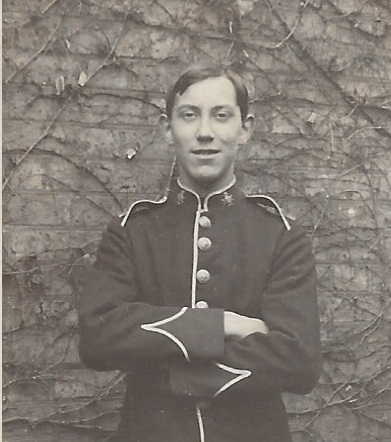William was born in Lewes in 1896 and baptised at St John sub Castro on 04/10/1896. He was the second child of Harry and Edith Reynolds, nee Piper, and at the time the family were living at 1 Bath Row. Harry was an iron trimmer at the Phoenix iron foundry and the family soon moved to 1 Phoenix Cottages. They were listed there in 1901 and again in 1911, by which time there were four children still living.

William in dress uniform prior to going overseas.
Little is known about William’s early life, but on later medical papers he says he had suffered with heart problems since childhood. Living that close to the foundry cannot have been conducive to having good lungs, especially when, by 1911, he was also working there as a core maker.
As with many local boys William joined the Royal Sussex Regiment enlisting into the 5th Cinque Ports Battalion on 16/05/1913, where he joined D Company who were centred in Lewes but drilled at Glynde and Stanmer. He was numbered TF/1659. This was a TF Battalion and William attended annual camp in 1913 and 1914.
Following the declaration of war the battalion was mobilised on 05/08/1914. William’s name appeared on the intercessions lists at St John sub Castro in September 1914. After further training the battalion travelled up to the Tower of London for inspection before setting off for France, arriving in Le Havre on 08/02/1915. William was now a member of C Company.
The battalion war diaries state that they were near Richebourg on 09/05/1915. The battle orders were that they were to form part of the second line, clearing trenches. To reach the enemy trenches they had to cross 250 yards of open country where they came under heavy rifle, machine gun and shell fire. In this first advance 30 rank and file were wounded or killed.
William was hit by shrapnel which entered his body at the 9th cervical vertebra level and exited just below his left clavicle. He was evacuated to hospital and invalided to the UK. The wound was operated on and healed in around 6 weeks but his heart gave concern and he remained in hospital for 17 weeks in all.
He was given an 8 day furlough after leaving hospital before transferring to the 2/5th Battalion at Hastings where he was put on light duties. This was a reserve battalion which did not go overseas. After just 3 weeks William was sent home unfit.
He went before a medical board on 21/10/1915 and was given an initial assessment. He was passed unfit for further service and discharged the service on 19/11/1915, but not awarded a full pension. The reason for this is likely to be that his heart condition was pre-existing before he served.
He appealed and went to 2 further medical boards where it was agreed that his injury had exacerbated the problem and he was listed as 100% disabled requiring full time care. His discharge papers were altered from saying ‘vascular disease of heart (aortic)’ to ‘Acute Military Tuberculosis’.
He was issued with a silver war badge on 28/11/1916. There had been a practice of women giving young men of military age white feathers if they appeared on the street not in uniform. The silver war badge was worn on the lapel and was an outward symbol that the man had already served his country and been injured.
William returned to 1 Phoenix Cottages and was looked after by his parents. He died at home on 08/10/1918 and was buried at St John sub Castro three days later. His grave is between the main path and the Russian Memorial.
William is remembered on the St John sub Castro Memorial as well as the Lewes War Memorial. He was entitled to the 1914 Star and the War and Victory medals, and these were sent to his father.




No Comments
Add a comment about this page